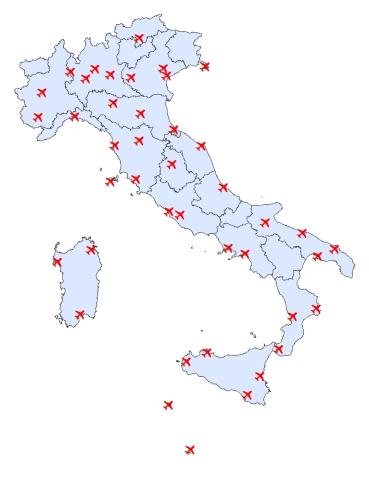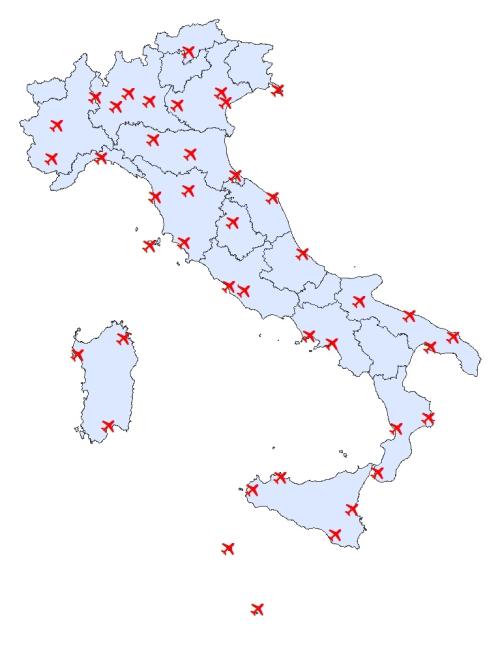Panel 1
Gabriele Bellabarba, Francesca Sacchetti
The management of noise pollution generated by airport infrastructures is carried out through the implementation of obligations set by current regulations. These include the approval of the acoustic characterization of the airport surroundings, a key territorial planning measure that regulates land use compatible with noise levels produced by the airport. Additionally, noise mitigation procedures are applied to minimize aircraft noise impact, along with the implementation and management of an airport noise monitoring system. To date, these obligations remain unfulfilled in many airports across the country. As of 2024, the acoustic characterization of the airport surroundings has been approved in 24 out of 42 airports handling national and international air traffic, 39 of which have been identified by ENAC as "airports of national interest", , marking a fundamental and priority step in the management of airport noise pollution.
This indicator reports the number of airports that have approved the acoustic characterization of their surroundings. For a more comprehensive overview, it also records: the number of airports where acoustic characterization is under evaluation, the number of airports that have approved noise abatement procedures and the number of airports that have installed an airport noise monitoring system.
To assess the implementation of national noise pollution regulations, particularly compliance with the obligations set by LQ 447/95 and its implementing decrees related to airport noise.
LQ 447/95; DM October 31, 1997; DM May 20, 1999; DM December 3, 1999
The protection of the outdoor environment and the interior of residential buildings from noise pollution is regulated by LQ 447/95 and its implementing decrees. Noise control for airport infrastructures is specifically governed by DM October 31, 1997, as well as later decrees covering noise abatement procedures and monitoring systems: DM October 31, 1997 – "Metodologia del rumore aeroportuale"; DM May 20, 1999 – "Criteri per la progettazione dei sistemi di monitoraggio per il controllo dei livelli di inquinamento acustico in prossimità degli aeroporti nonché criteri per la classificazione degli aeroporti in relazione al livello di inquinamento acustico"; DM December 3, 1999 – "Procedure antirumore e zone di rispetto negli aeroporti".
This regulatory framework mandates that each airport open to civil traffic establish a Commission (Art. 5, DM October 31, 1997) responsible for: defining noise abatement procedures; establishing the acoustic characterization of airport surroundings, identifying three protection zones (A, B, and C) based on noise level variability (LVA descriptor) and predominant land use; classifying airports using three indices related to the extent of protection zones, types of surrounding settlements, and population density.
Panel 2
SNPA 2023, Linee Guida SNPA n. 45/2023 - Linee guida per la definizione della caratterizzazione acustica dell'intorno aeroportuale
ISPRA, 2010, Linee guida per la progettazione e la gestione delle reti di monitoraggio acustico aeroportuale
APAT CTN_AGF, 2004, Criteri per l’utilizzo dei modelli di calcolo per il rumore aeroportuale nell’ambito dell’applicazione delle procedure antirumore e nella determinazione degli intorni aeroportuali
APAT CTN_AGF, 2003, Criteri per la validazione dei modelli di simulazione del rumore aeroportuale e metodologia di verifica dei risultati del loro impiego
--
--
Data quality assessment
ENAC (National Civil Aviation Authority)
ISPRA/ARPA/APPA
MASE (Ministry of Environment and Energy Security)
ENAC https://www.enac.gov.it/aeroporti/infrastrutture-aeroportuali/aeroporti-in-italia
National
Update as of 31/12/2024.
Indicator assessment
The indicator reports the number of airports with approved acoustic characterization of their surroundings.It also records: the number of airports where the characterization is under evaluation, the number of airports with approved noise abatement procedures and the number of airports with active noise monitoring systems.
As of 2023, 24 out of 42 airports handling national and international air traffic had their acoustic characterization approved by their respective Airport Commissions, an essential and priority measure in managing airport noise pollution.
There have been minor variations compared to the previous year.
Data
Table 1: Status of Implementation of the Noise Characterization of Airport Surroundings
ISPRA/ARPA/APPA, MASE, ENAC


There are approximately 101 airports across the country, classified into various categories (civil, private, military, military open to civil traffic, mixed-use). Commercial national and international air traffic is concentrated in 42 airports, 39 of which are designated by ENAC as airports of national interest (Figure 1).
Table 1 provides details on the implementation status of acoustic characterization, which has been approved in 24 airports and is under evaluation in 4 others. It also presents data on: noise abatement procedures, defined in 26 airports, and airport noise monitoring systems, managed by airport operating companies and currently active in 23 of the 42 airports.